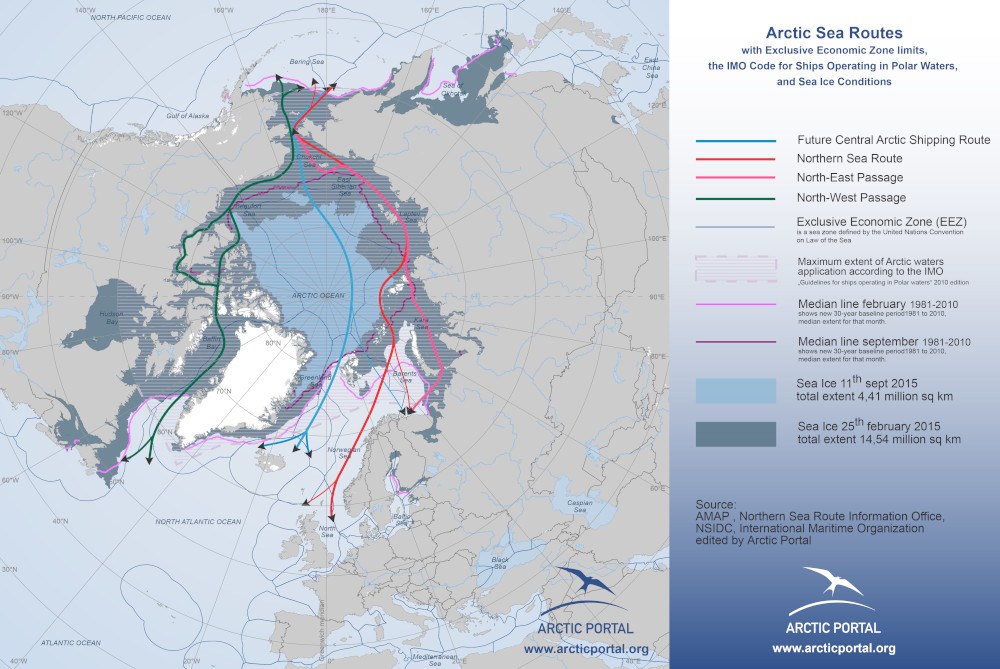Governance of Arctic shipping is a complex and evolving issue shaped by a mix of domestic laws, international legal frameworks, and non-binding regional agreements. Currently, no single comprehensive legal regime governs the entire Arctic Ocean, and there is no multilateral body with authority to enforce legally binding decisions on Arctic activities. However, several mechanisms and institutions contribute to oversight and coordination in the region.
The Role of the Arctic Council
The Arctic Council, established in 1996 by the eight Arctic states, serves as the primary intergovernmental forum for promoting cooperation, coordination, and interaction in the Arctic—particularly in matters related to environmental protection, sustainable development, and Indigenous affairs.
While the Council lacks regulatory powers or authority to impose legally binding rules, it plays an influential role by developing assessments, fostering regional identity, and guiding Arctic policy. Its outputs are grounded in scientific expertise and consensus-based decision-making.
Economic and Strategic Interests in the Arctic
The Arctic continues to attract significant global interest due to its resource potential and the prospect of new shipping routes. The shelves of the northern seas are believed to hold substantial fossil fuel reserves, increasing the region's importance for future energy security. Moreover, ongoing reductions in sea ice have sparked visions of more accessible Trans-Arctic sea routes, notably the Northern Sea Route and the Central Arctic Ocean Route.
At the same time, growing insecurity in other global chokepoints—such as piracy in the Suez Canal—has further piqued interest in the Arctic as an alternative corridor for maritime trade.
Geopolitical Dynamics and Environmental Risks
Strategic competition and sovereignty claims in the Arctic have intensified in recent years, fueled by global energy demands and geopolitical tensions. These trends have also brought risks, including threats to the fragile Arctic environment, challenges to local governance, and potential undermining of Indigenous rights.
Such developments underscore the need for stronger international cooperation—both among Arctic states and with global partners—to address shared challenges and promote sustainable development in the region.
 The International Maritime Organization (IMO)
The International Maritime Organization (IMO)
The International Maritime Organization (IMO), founded in 1948 and headquartered in London, is the leading global authority on maritime safety and environmental protection. It has developed a wide body of legally binding conventions and voluntary guidelines that apply globally, including in the Arctic.
IMO conventions cover various regulatory areas such as:
- CDEM (construction, design, equipment, and manning),
- Navigation standards,
- Pollution discharge and emissions,
- Contingency planning,
- Liability and compensation regimes.
Although most IMO instruments are global in scope, the organization has issued voluntary Polar Guidelines, which formed the basis for the Polar Code—a mandatory framework that came into force in 2017. The Polar Code applies to ships operating in Arctic and Antarctic waters, enhancing maritime safety and environmental protection in polar regions.
Arctic Council’s Work on Shipping
Assessments and Frameworks
One of the most influential Arctic Council contributions to maritime governance is the Arctic Marine Shipping Assessment (AMSA), produced by the Protection of the Arctic Marine Environment (PAME) working group. Released in 2009, AMSA outlined key recommendations under three pillars:
- Enhancing Arctic marine safety
- Protecting Arctic people and the environment
- Building Arctic marine infrastructure
These recommendations continue to guide Arctic marine policy and were endorsed in the Tromsø Declaration of April 2009.
Key Working Groups Involved
The Emergency Prevention, Preparedness and Response (EPPR) Working Group is the main Arctic Council body addressing shipping-related emergencies. It focuses on:
- Oil spill preparedness and response
- Environmental risk assessments
- Best practices in shoreline clean-up
Key EPPR outputs include:
- Arctic Guide (updated annually)
- Field Guide for Oil Spill Response in Arctic Waters
- Environmental Risk Analysis of Arctic Activities
- Circumpolar Map of Resources at Risk from Oil Spills in the Arctic
- Shoreline Clean-up Assessment Technique (SCAT) Manual
In recent years, EPPR has expanded its scope to include radiological emergency preparedness and search and rescue cooperation. These areas reflect growing attention to operational risks posed by increased shipping traffic and resource development.
Conclusion
Although no single body governs all Arctic shipping, a combination of global conventions, regional cooperation, and evolving soft law instruments forms a patchwork of governance. The Arctic Council, while non-regulatory, plays a central role in shaping norms and promoting cooperation, and the IMO continues to set global standards that apply in the region.
As the Arctic continues to change rapidly, enhanced cooperation and integrated frameworks will be essential to manage maritime activity responsibly and sustainably.
Source: The Arctic Council,International Maritime Organization Maps: Arctic Portal (to view more maps visit our Map Gallery)










